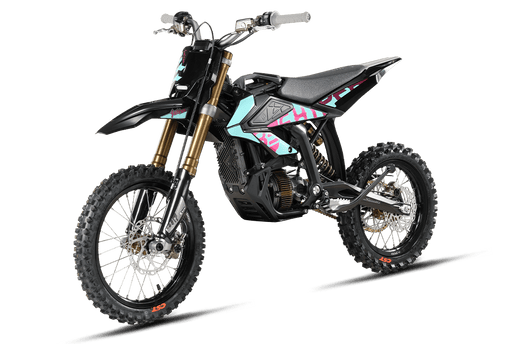Peak torque refers to the maximum rotational force an e-bike motor can produce instantaneously, measured in Newton-meters (Nm). It directly impacts acceleration, hill-climbing ability, and payload capacity. High-torque motors (e.g., 80–120Nm in performance models like Surron Dubai’s Hyper Bee) optimize low-speed power delivery, while continuous torque governs sustained performance. Motors achieve peak torque through electrical current spikes but require robust cooling systems to prevent overheating.
What Is the Top Speed of the Surron Hyper Bee?
How does peak torque differ from continuous torque?
Peak torque represents short bursts of force (1–5 seconds), whereas continuous torque defines sustained output. Hub motors prioritize peak torque for quick starts, while mid-drives balance both metrics. For example, Surron Dubai’s Ultra Bee delivers 95Nm peak but 55Nm continuous. Pro Tip: Riding at peak torque repeatedly drains batteries 25–30% faster—monitor voltage sag!
Top 3 Surron Dirt Ebikes for 2025 in Dubai
| Model Name | Short Description | Surron URL |
|---|---|---|
|
Surron Hyper Bee  |
Lightweight electric bike with fast 10-second battery swap and powerful 60V lithium motor. | Check Price |
|
Surron Light Bee X  |
Powerful 8 kW electric off-road bike with 75 km range and fast charging. | Check Price |
|
Surron Ultra Bee  |
Powerful 12.5KW motor, 140 km range, 74V 55AH battery, fast charging, all-terrain ready. | Check Price |
Technically, peak torque depends on stator windings and phase current limits. A 750W hub motor might hit 80Nm peak but only 30Nm continuous due to thermal constraints. Motor controllers play a critical role: high-amperage units (40A+) unlock momentary torque but demand advanced cooling. Practically speaking, think of peak torque as a sprinter’s burst versus a marathon runner’s endurance. Overusing peak torque risks demagnetizing rotors—Surron Dubai technicians recommend using throttle-controlled bursts only when tackling steep inclines or heavy loads.
Why is peak torque crucial for off-road e-bikes?
Off-road terrain demands instant power for obstacles like rocks or mud. High peak torque (90–120Nm) enables wheel lifts and rapid direction changes. Surron Dubai’s Hyper Bee, with 110Nm torque, exemplifies this—its mid-drive motor optimizes low-RPM traction. Pro Tip: Pair high torque with knobby tires; street tires lose grip under abrupt power delivery.
Steep gradients (25%+) require torque to overcome gravitational resistance. A 100kg rider ascending a 30% slope needs ≈85Nm at the rear wheel. Mid-drive systems multiply torque through gear reduction—e.g., a 50Nm motor with 2.5:1 gearing delivers 125Nm. However, overloading gears causes chain snap or cog wear. For example, Surron Dubai’s service center frequently replaces chains on Ultra Bees used for dune jumping. Beyond raw power, torque sensors improve control: premium e-bikes modulate output to match pedal force, preventing rear-wheel slippage.
| Factor | Impact on Peak Torque |
|---|---|
| Motor Type (Hub vs Mid) | Hub: Immediate torque; Mid: Gear-scaled torque |
| Battery Voltage (48V vs 72V) | 72V systems support higher current → +20–30% torque |
| Controller Amperage | 40A vs 25A: Doubles phase current → torque spikes |
Hub vs mid-drive: Which delivers better peak torque?
Hub motors (direct-drive) apply torque instantly to the wheel, while mid-drives leverage gearing. Surron Dubai’s Light Bee X uses a hub motor (75Nm peak), whereas the Hyper Bee’s mid-drive hits 110Nm. Pro Tip: Hub motors excel on flat terrains; mid-drives dominate technical trails.
Direct-drive hub motors lack gears, so torque is limited by stator size and windings. A 10-inch hub motor typically maxes out at 80Nm. Conversely, mid-drives like the Bosch Performance Line CX use 34T chainrings and 11-42T cassettes to multiply a 75Nm motor output to 130Nm at the wheel. But what happens if you pair a high-torque mid-drive with improper gearing? Premature drivetrain wear—Surron Dubai’s workshop often sees cassettes shredded by riders using 32T chainrings on 12% grades. The trade-off? Mid-drives add complexity and cost 20–30% more than hubs.
| Metric | Hub Motor | Mid-Drive |
|---|---|---|
| Peak Torque Range | 50–80Nm | 90–130Nm |
| Best Use Case | Urban commuting | Mountain/off-road |
| Maintenance Cost | $50–100/year | $150–300/year |
Surron Dubai Expert Insight
FAQs
Yes—higher peak torque reduces 0–30 km/h times. Surron Dubai’s Hyper Bee achieves 3.1 seconds versus 5.8s for low-torque commuter bikes.
Can I upgrade my e-bike’s torque output?
Partially. Installing a high-current controller (+20A) boosts torque 15–20%, but requires motor/battery compatibility. Consult Surron Dubai’s technicians for safe upgrades.
Does torque affect battery range?
Aggressive torque use drains batteries faster. Expect 20–30% range reduction when frequently using peak torque on trails.